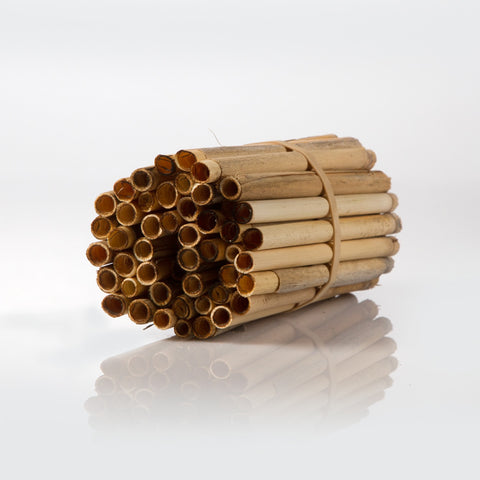Top Nesting Materials for Solitary Bees
In the wild solitary bees find a nesting place under rocks, beneath bark, and in holes in dead trees. Does it really matter what type of nesting materials are used? Maybe it seems like the options are complicating things a bit? Here at masonbeesforsale we have a lot of experience trapping native bees and know what the bees like best. This is the post where we share our insider knowledge on nesting materials so you can provide the best home for your bees.
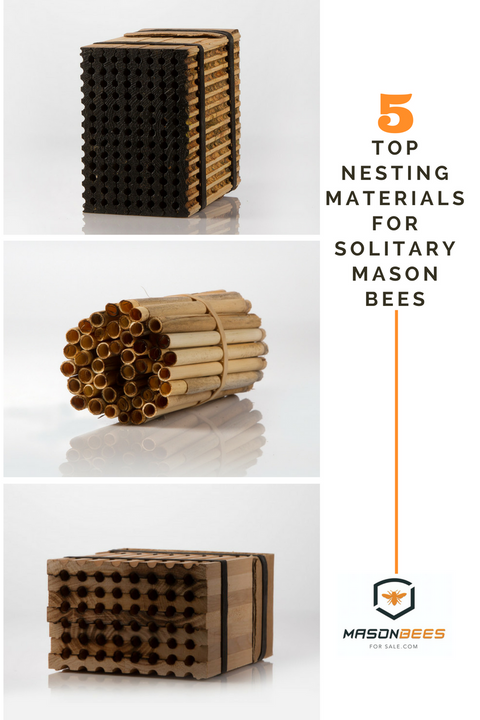
Phragmite Reed Tubes:
pros: Phragmite Reeds are by far our top choice in nesting materials! They are the best option for several reasons,
1- Size/Shape-Reed tubes naturally vary in size, bees also vary in size and preferences so most bees will find a size they like to nest in. Each tube is cut between nodes so there is a natural back wall. Solitary bees prefer a fully enclosed space to nest in.
2-Protection-They are pest resistant. Mites and parasites aren’t able to burrow through the sides/backs of the tubes.
3-Waterproof– Water will not soften or ruin the tubes. phragmite reeds will naturally wick away moisture. This also decreases the risk of mold, fungus and mildew affecting the bees.
4-Sustainable-Each reed is hand cut to the ideal length (approx. 6inches) from natural sources. Cutting reeds is more environmentally friendly than the burning that usually takes place to get rid of the reeds.
5-Easy Sorting– At the end of the season the reed tubes can easily be split in half. Bees can easily be sorted without damaging the cacoons.
cons:
1- Disposable-Reeds need to be replaced after each season, this requires purchasing new tubes. Luckily they are affordable.
2- Predators– Squirrels and Raccoons are sometimes able to get the tubes out of the bee house if not packed tightly enough. Placing some chicken wire over the front of the bee house and packing the reed tubes tightly in the house will prevent predators from getting your bees. Purchase your Phragmites Reed Tubes Here.
Wooden Laminates- The second best option (in our opinion)
Pros:
1-Easy Sorting– The wooden laminates easily separate to sort bees without damaging cacoons.
2-Easy to Clean– It is easy to split the wooden laminates and brush them out at the end of the season.
3- Reusable– Laminates can be cleaned and reused for the next season.
4-Convenient Set Up-It is simple to band and put laminates in the bee house.
5- Water Resistant-will not soften when wet, decrease risk of mold and mildew.
6- Predator Resistant– It is harder for squirrels and raccoons to break open the laminates (though it has been done).
Cons:
1-Not as Attractive to Bees– Bees would rather nest in reed tubes than in laminates. While testing side by side the bees chose to lay in reed tubes before laminates every time. Laminates do not feel as natural to the bees, the diameters are uniform for either mason bees (larger) or leaf cutter bees (smaller). Bees generally aren’t one size fits all and would rather have the variable sizes found in reed tubes.
2- Heavier– Laminates add weight to the house so be sure to hang in a secure place.
3-Parasites/Mites– If the laminates are not banded together tight enough or if the backing is not secured properly mites and parasites can crawl in the gaps and get to multiple tubes of bees. Proper set up will prevent the spread of parasites and mites.
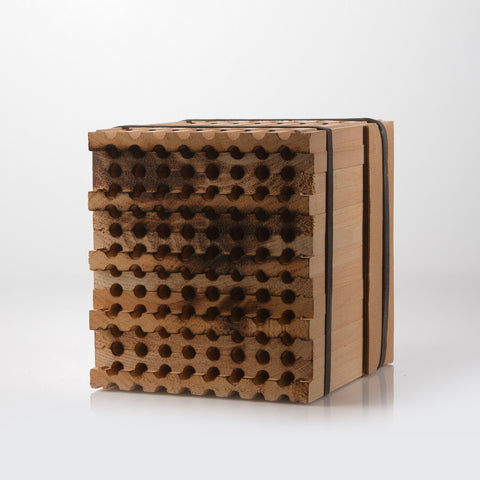
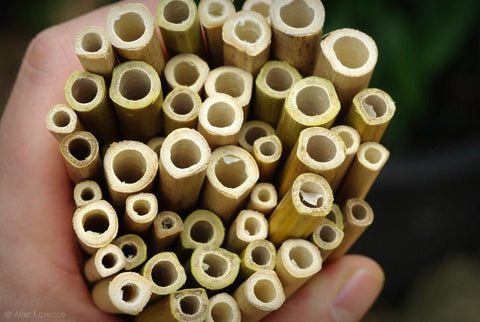
Bamboo Tubes
pros:
1-Natural- Bees are attracted to the natural tubes.
2- Pest Ristant– Bamboo is strong, parasites and mites aren’t able to penetrate the tubes.
3-Waterproof- Water will not soften tubes, reducing mold and mildew.
cons:
1- Strength– sounds like a pro but the strength of bamboo tubes make them difficult to impossible to open for sorting bees. Bees are more likely to be injured.
2-Disposable- Bamboo tubes should be disposed of at the end of each season, reusing tubes that have not been properly cleaned is a way to attract mites and parasites in your bee house.
3-Availability– Bamboo is not as available as other resources.
Cardboard Tubes
pros:
1-Affordable– Cardboard tubes are the cheapest nesting material.
2-Man Made– Cardboard is a common material and they are readily available.
3-Easy to clean– at the end of the season it is easy to open the tubes without damaging the cacoons (though it is more time consuming to unwrap them instead of splitting the reeds or unbending the laminates).
Cons:
1-Size- Cardboard tubes are one size (5/16ths of an inch). The bees prefer the variable sizes of phragmite reeds and bamboo tubes.
2-Fragile– The major down side to cardboard tubes is the lack of protection they offer. Water will soften the tubes easily, there are more problems with mold and mildew, and parasites can burrow through the sides of the tubes and get to your bees.
3-Predators– Squirrels, ants and other predators can make quick work of eating through the card board tubes. Adding chicken wire to the front of your house and placing house at least 3 feet off the ground will help deter them though.
4- Disposable– Cardboard tubes need to be replaced each year. This is largely not a problem because they are very affordable.
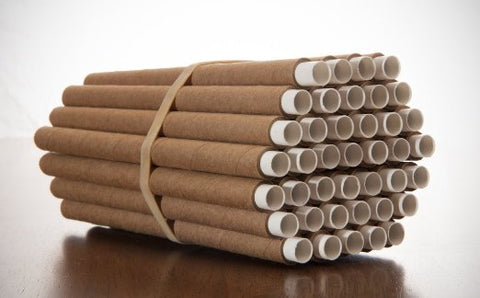
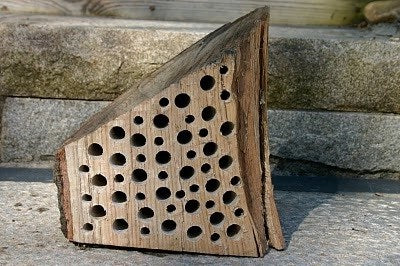
Blocks with drill holes– WE DO NOT RECOMMEND! (Please choose an option easier to clean without harming bees.)
pros:
1-Natural/size- Bees are attracted to the natural wood (some types are more attractive than others) and you can use varying drill bit sizes to provide variation for the bees. The bees prefer a smoother hole however and would rather nest in a reed or bamboo tube.
2- Pest Resistant– Parasites and predators will not be able easily get to the bee larva. The problem arises when the holes are not cleaned out after the first year. Parasites and mites tend to build up in the holes, which can kill all the bees for the next season.
3-Waterproof- Water will not soften holes and there usually isn’t a problem with mold or mildew. Make sure to mount your house on a slight angle to allow any water that does enter the holes to be able to run out easily.
4-DIY- It is easy to drill holes in wood and create your own set up. This is the top reason to choose this option. Unfortunately few realize that these blocks though fine for the first year or so lead to a lot of problems in following years. Even to the point of killing all the good bees in your home and allowing the wasps and other parasites to flourish. (Not what we want to accomplish)
cons:
1- Solid– At the end of the season it is best to clean out the house and sort the bees. This allows us to get one up on natural parasites and unwanted wasps ect… Wood blocks are solid, there is no way of opening the holes without damaging the bee cocoons. This means that whatever is in the nest stays there. Including the possible wasps, parasites and mites. Some people will re-drill holes that look used but there is a risk of killing good bees in the process. Besides the fact that the holes that look filled may be harboring pests.
2-Size/length- It is sometimes difficult to drill holes the correct length for bees (they need approx. 6 inch tubes to lay the correct ratio of male and female bees). The drill holes are rougher than other tubes and and wood splinters can damage bee wings.
Contact us
At Mason Bees, we are here to answer any questions you may have. Whether you are interested in any of our products for you own personal garden or for your orchard, we have a solution for you. Feel free to reach us directly and we will respond as soon as possible.
Phone number: 8016489035
Email: masonbeesforsale@gmail.com
Address: Mason Bees LLC,
10090 N HIGHWAY 38, DEWEYVILLE UT 84309, United States
Get Mason Bees
Boost your garden's productivity by providing a Mason Bee House for peaceful, non-stinging bees. As bee populations struggle, home gardeners can play an important role in attracting bees and other pollinators
News & Updates
Sign up to get the latest on sales, new releases and more …
© 2025 masonbeesforsale.com. Designed by Out of the Sandbox. Powered by Shopify


